An article from WWA’s Words From The Wardens.
This article originally appeared in Wisconsin Waterfowl Association’s July 2020 eNewsletter.
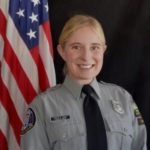 By DNR Conservation Warden Meghan Jensen. Photos by DNR Lt. Tyler Strelow
By DNR Conservation Warden Meghan Jensen. Photos by DNR Lt. Tyler Strelow
Much of a Wisconsin conservation warden’s first year is spent on training. Newly hired wardens attend the basic law enforcement academy, go through field training and attend several specialized trainings specific to enforcement activities.
All of these trainings together help prepare new wardens for their role to protect Wisconsin’s natural resources and the people who enjoy them.
Of all of the specialized trainings, waterfowl enforcement training is a favorite among many new wardens. We are fortunate to have so many partners who assist – and that includes support from the Wisconsin Waterfowl Association.
Held in the La Crosse area, the waterfowl training provides new wardens with the opportunity to learn about waterfowl identification, enforcement techniques, and provides them with the opportunity to work alongside seasoned wardens during the waterfowl season to enhance their skills.
Waterfowl enforcement training includes both classroom and in-the-field training.
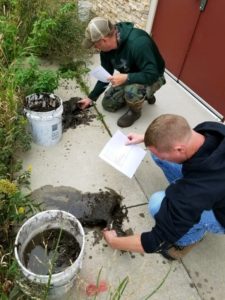
Bucket-O-Ducks: New wardens complete their final test where they must identify ducks that have been placed in muddy water to represent what they may see in the field.
To begin, the new wardens are faced with a pre-test to assess their knowledge of waterfowl identification. At the end of their classroom training, they complete a longer, more in-depth test. The final test includes identification of waterfowl based on photographs, wings, full-body mounts, and even waterfowl specimens in buckets of muddy water. Recruits then compare their pre-test with their post-test and see how much they learned.
The training the new wardens receive is taught by seasoned wardens who are passionate about waterfowl hunting and enforcement, lending them to be excellent instructors and mentors.
Much of the training is focused on waterfowl identification. New wardens spend several hours learning how to identify waterfowl primarily by their wings. The identification training includes a classroom presentation by instructors who utilize a variety of learning aids, including wing and full body specimens and identification booklets to help the new wardens get hands-on experience.
New wardens also have an opportunity to head out into the marsh to practice their waterfowl identification skills on the wing. This portion of the training allows new wardens to see waterfowl in their natural habitat and allows instructors the opportunity to point out unique characteristics of the different waterfowl species.
New wardens also learn about equipment used for waterfowl hunting and enforcement, state and federal waterfowl laws, and different enforcement techniques. During this portion of the training, new wardens get hands-on experience with ammunition and firearm handling, watch and participate in demonstrations of enforcement contacts, and have the opportunity to look at gear and equipment commonly used by waterfowl hunters.
On the last day of the structured training, new wardens are tested during a series of real-life scenarios in a controlled environment. Scenarios are designed to be as realistic as possible to help create the feeling of contacting an actual waterfowl hunter in the field. Entering into a scenario, the new warden is given basic information, but is never given all the information, which allows them to utilize the skills they have learned throughout their training and determine whether or not a violation has occurred.
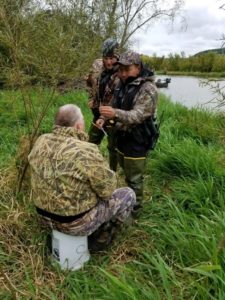
Scenario Training: New wardens conduct field sobriety testing on a possible intoxicated hunter during one of the scenarios.
To make the scenarios as realistic as possible, we utilize citizen volunteers as actors, have waterfowl specimens, and utilize training ammunition and firearms. Since most of our volunteers are avid waterfowl hunters themselves, they usually provide additional gear to simulate a realistic set-up. New wardens also get to experience operating and making approaches with different style boats and canoes that are typically found in a waterfowl hunting setting. At the completion of each scenario, a seasoned warden provides feedback on how the new warden did with the scenario.
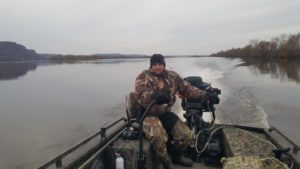
Field Work: New warden operates a shallow water boat while working waterfowl enforcement on the Mississippi River.
The final part of the waterfowl enforcement training is for new wardens to be paired with a seasoned warden and work waterfowl enforcement in the field. Typically this has been done during the state’s season opener. This experience culminates the waterfowl enforcement training and allows the new wardens to practice all their skills they have just learned.
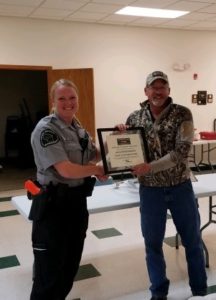
Top Test Score 2019: WWA Executive Director Bruce Ross presents Warden Mary Bisch with the 2019 Top Test Score award. Congratulations Mary!
The Wisconsin warden waterfowl enforcement training would not be possible without all the skilled and passionate instructors and volunteers that help make the training successful. We are also very fortunate to have support from the Wisconsin Waterfowl Association each year. In addition to providing actors and gear for our scenario day, the WWA has annually recognized the training’s “top test score” warden. This is a coveted honor and a recognition that the recipient will cherish for the rest of their career.
